2014年文体学试卷
2014年《汉语语言文学》试题及答案 (2)

2014年全国中级导游员等级考试《汉语言文学知识》试题一、单项选择题(下列各题只有一个正确答案,请将正确答案前的英文字母填入答卷中相应题号后的空格内。
每小题1分,共44分)1、广义的【】指所有的古体文字。
A.篆文 B.大篆 C.石鼓文 D.金文2、1964年国家公布的《简化字总表》,简化汉字共【】个。
A.1235 B.2235 C.3235 D.42353、彻底排除汉字中的象形符号,把汉字变成由点、横、撇、捺组成的单纯书写符号的字体是【】。
A.楷书 B.金文 C.隶书 D.篆书4、用两个或两个以上的字组合起来表示一个新的意义的造字方法,称为【】。
A.形声 B.转注 C.指事 D.会意5、人文景观的讲解应以【】为主。
A.叙述、描写 B.叙述、说明 C.叙述、议论 D.说明、议论6、旅游文学是一种语言艺术,能通过【】的美感潜移默化地影响旅游者。
A.艺术创意 B.艺术形象 C.艺术形式 D.艺术风格7、诗句“岚光叠翠巍云塔,湖影回廊漾梵楼”中的“岚光”指的是【】。
A.清晨的霞光 B.山里的雾气 C.湖面的雾气 D.湖中的波光8、诗句“白雪横千嶂,青天泻二流。
登封如可作,应待翠华游”中的“翠华”代指的是【】。
A.春季 B.夏季 C.百姓 D.皇帝9、“龙涧风回,万壑松涛连海气;鹫峰云敛,千岩桂月映湖光”是描写【】最精彩的对联。
A.独秀峰 B.寒山寺 C.灵隐寺 D.雁荡山10、对联“绝妙朋游,有明月一杯,好山四座;是何意态,看大江东去,秋色西来”所描述的清幽风景是【】。
A.吉林北山药王庙 B.吉林北山关帝庙 C.吉林北山玉皇阁 D.吉林北山坎离宫11、诗句“负冰锦鬣游文沼,试暖文禽绕鱼堂”中“试暖”一词化用了【】诗句中“”春江水暖鸭先知。
A.苏轼 B.李清照 C.陆游 D.辛弃疾12、曹操诗“东临碣石,以观沧海。
水何澹澹,山岛竦峙”中“碣石”指的是【】。
A.碣石港 B.碣石山 C.碣石碑 D.碣石镇13、《晋祠门联》中的“巍巍冠盖日纵横,景其美兮,景其淑兮。
全国2014年4月高等教育自学考试应用文写作试题

全国2014年4月高等教育自学考试应用文写作试题第一篇:全国2014年4月高等教育自学考试应用文写作试题绝密★ 考试结束前全国2014年4月高等教育自学考试应用文写作试题课程代码:02126选择题部分请考生按规定用笔将所有试题的答案涂、写在答题纸上。
注意事项:1.答题前,考生务必将自己的考试课程名称、姓名、准考证号用黑色字迹的签字笔或钢笔填写在答题纸规定的位置上。
2.每小题选出答案后,用2B铅笔把答题纸上对应题目的答案标号涂黑。
如需改动,用橡皮擦干净后,再选涂其他答案标号。
不能答在试题卷上。
一、单项选择题(本大题共22小题,每小题1分,共22分)在每小题列出的四个备选项中只有一个是符合题目要求的,请将其选出并将“答题纸”的相应代码涂黑。
错涂、多涂或未涂均无分。
1.任何违背客观实际的立意,必然远离社会的需要,因此立意应A.符合具体工作的需要C.集思广益2.应用文内容的组成,除了主旨以外,还有A.立意C.材料3.对客观事物进行解释、阐述的表达方式是A.叙述C.记叙 B.说明 D.演绎 B.具体工作 D.分析 B.符合客观实际的需要 D.分析归纳4.把两种性质、特征各不相同的事物加以对照,使他们彼此的本质显现得更加突出和鲜明的论证方法是A.归纳论证法C.比喻论证法5.市场调查报告应及时反馈市场信息,因此市场调查报告具有A.事实性C.广泛性 B.针对性 D.时效性 B.对比论证法 D.因果论证法6.对经济项目建设的必要性、可行性持肯定、否定两种态度,分析得失、利弊,提供两种建议,供企══════════════════════════════════════════════════════════════════════-本套试题共分4页,当前页是第1页-业决策者选择的经济项目可行性研究报告是A.肯定性报告C.分析性报告 B.选择性报告 D.模糊性报告7.把两个或两个以上的时间、内容、项目、条件基本相近或相同的具有可比性的数据资料加以对比,计算、研究它们的差异,并分析其中原因的一种市场活动分析方法是A.集合意见法C.专家意见法 B.类推法 D.比较分析法8.不针对消费者制作的商品广告,很难发挥其宣传商品、促售商品的作用,因此商品广告写作时要求A.创造性强C.说服力强 B.针对性强 D.议论充分9.慰问信要全面地概括慰问对象的可贵精神,并对其提出希望和祝愿,以勉励他们继续努力工作和奋斗,从而取得更大的成绩,因此慰问信写作时要求A.感情真挚C.号召力强 B.论证充分 D.语气恳切10.一般情况下,欢迎词和欢送词都是一种礼节性的外交或公关辞令,因此写作时要求A.短小精悍C.条款明确 B.长篇大论 D.有理有据11.演讲一般都是在群众集会或会议上进行的,因此具有特点A.受众广泛C.具体性 B.听众热情高 D.主动性12.开幕词要向会议发出号召、提出希望,确保会议顺利召开、圆满结束。
2014年普通高等学校招生统一考试新课标Ⅰ语文科类卷文科类档版(有答案)

(新课标卷Ⅰ)2014年普通高等学校招生全国统一考试语文试卷及答案学科网第Ⅰ卷阅读题甲必做题一、现代文阅读I 9分,每小题3分)阅读下面的文字,完成l~3题。
悲剧产生于社会的矛盾、两种社会力量的冲突。
冲突双方分别代表着真与假、善与恶、新与旧等对立的两极,却总是以代表真、善、新等美好的一方的失败、死亡、毁灭为结局,他们是悲剧的主人公。
因为他们的力量还比较弱小,还无法与强大的旧势力或邪恶力量抗衡,正义的要求不能实现,于是形成了悲剧。
古希腊学者亚里士多德指出,悲剧描写了比现实中更美好同时又是“与我们相似的”人物,通过他们的毁灭“引起怜悯和恐惧来使感情得到陶冶”,即产生净化的作用。
然而,悲剧不仅表现冲突与毁灭,而且表现抗争与拼搏,这是悲剧具有审美价值的最根本的原因。
鲁迅说过:“悲剧将人生的有价值的东西毁灭给人看”。
这种毁灭是抗争、拼搏以后的毁灭,抗争与拼搏体现了人的一种精神。
古希腊神话中普罗米修斯为了人类从天上盗取火种,触怒了主神宙斯,被锁在高加索山崖上,每日遭神鹰啄食肝脏,但普罗米修斯毫不屈服,最后坠入深渊。
罗丹的大理石雕塑《马身人首》中,人臂绝望地扑向一个它所抓不到的目标,而马足则陷于尘土不能自拔,表现出人性学科网与兽性的冲突,象征着灵与肉的斗争,具有强烈的悲剧性。
可以说,没有抗争就没有悲剧,冲突、抗争与毁灭是构成悲剧的三个主要因素。
悲剧的审美价值的载体只能是文学艺术。
因为人生有价值的东西、美好事物的毁灭是令人伤悲的,因此现实中的悲剧不能作为直接的审美对象来欣赏,否则人就是泯灭了人性的人了。
现实中的悲剧只能激起人的同情、义愤,迫使人采取严肃的伦理态度和实践行动。
民主革命时期,在演出歌剧《白毛女》的过程中,曾多次出现扮演地主黄世仁的演员被打甚至险遭枪击的事件,这是人们以实际的道德评价代替了审美活动。
现实的悲剧只在客观上具有悲剧的审美性质,它们必须以文学艺术的形式表现出来,才能成为欣赏的对象,美学上所谓的“以悲为美”才能实现。
00524_2014_4 _文书学
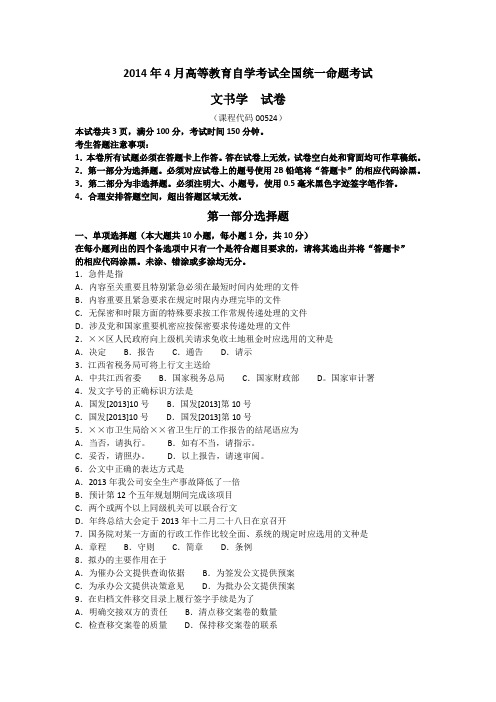
2014年4月高等教育自学考试全国统一命题考试文书学试卷(课程代码00524)本试卷共3页,满分100分,考试时间150分钟。
考生答题注意事项:1.本卷所有试题必须在答题卡上作答。
答在试卷上无效,试卷空白处和背面均可作草稿纸。
2.第一部分为选择题。
必须对应试卷上的题号使用2B铅笔将“答题卡”的相应代码涂黑。
3.第二部分为非选择题。
必须注明大、小题号,使用0.5毫米黑色字迹签字笔作答。
4.合理安排答题空间,超出答题区域无效。
第一部分选择题一、单项选择题(本大题共10小题,每小题1分,共10分)在每小题列出的四个备选项中只有一个是符合题目要求的,请将其选出并将“答题卡”的相应代码涂黑。
未涂、错涂或多涂均无分。
1.急件是指A.内容至关重要且特别紧急必须在最短时间内处理的文件B.内容重要且紧急要求在规定时限内办理完毕的文件C.无保密和时限方面的特殊要求按工作常规传递处理的文件D.涉及党和国家重要机密应按保密要求传递处理的文件2.××区人民政府向上级机关请求免收土地租金时应选用的文种是A.决定B.报告C.通告D.请示3.江西省税务局可将上行文主送给A.中共江西省委B.国家税务总局C.国家财政部D。
国家审计署4.发文字号的正确标识方法是A.国发[2013]10号B.国发[2013]第10号C.国发[2013]10号D.国发[2013]第10号5.××市卫生局给××省卫生厅的工作报告的结尾语应为A.当否,请执行。
B.如有不当,请指示。
C.妥否,请照办。
D.以上报告,请速审阅。
6.公文中正确的表达方式是A.2013年我公司安全生产事故降低了一倍B.预计第12个五年规划期间完成该项目C.两个或两个以上同级机关可以联合行文D.年终总结大会定于2013年十二月二十八日在京召开7.国务院对某一方面的行政工作作比较全面、系统的规定时应选用的文种是A.章程B.守则C.简章D.条例8.拟办的主要作用在于A.为催办公文提供查询依据B.为签发公文提供预案C.为承办公文提供决策意见D.为批办公文提供预案9.在归档文件移交目录上履行签字手续是为了A.明确交接双方的责任B.清点移交案卷的数量C.检查移交案卷的质量D.保持移交案卷的联系10.归档章应当加盖在A.公文首页上方空白处B.正文字迹上C.首页领导批示意见上D.收文章上二、多项选择题(本大题共5小题,每小题2分,共10分)在每小题列出的五个备选项中至少有两个是符合题目要求的,请将其选出并将“答题卡”的相应代码涂黑o未涂、错涂、多涂或少涂均无分。
2014--2015第二学期应用文写作期末试卷.pdf

A. 盼复
C. 以上情况当否 ,请批复
26、D下.列特情此况函应复使用函的一项是 ( )
A. 因经营发展 ,现有营业用房不足 ,拟兴建商场 2000 平方
B. C.
某台胞与企业合资的优惠政策已经落实 某皮件公司同意接受省畜产品进出口公司委托来料加工山羊皮一万张
D. 大华装潢家具厂请求市财税三分局请
2 7、根据新的《国家行政机关公文处理办法》,现行国家行政机关公文文种有( A 、11 种 B、12 种
隆德县职业中学 2014- 2015 学年度第二学期理论考试
高一年级 3、4 班应用文写作基础期末试卷
(命题人:张丽萍 考试时间: 120 分钟,满分: 100 分,共六大题)
一
二
三
四
五
六
总分
审核人
评卷人
得 分 一 、填空题。(本题
1、向不相隶属的单位请求答复批准,使用
。
2、按照行文关系、 文件去向看,报告和请示都是
上级都应当作出答复。
(
) 3 7、公文中的标题,一律不用标点符号。
(
) 3 8、关于申请资金修建学生公寓楼的报告。
(
告行文。
(
(
) 4 1、县教育局请求县财政局增拨希望工程资金,应该使用的文种是函。
(
) 42、函的写作,要求开门见山,直叙其事,措辞得体,平等待人,一般不
用“不用”、“应该”、“注意”等指示性语言。
A.通报
B.通知
C.公文 D.批复
2 3、“现将有关事项通知如下”属于应用文结构用语中的( )
A 、开头用语 B、结尾用语 C、过渡用语 D、综合用语
2 4、下列情况不属于函使用范围的一项是 )(
常用文体写作A试卷及答案
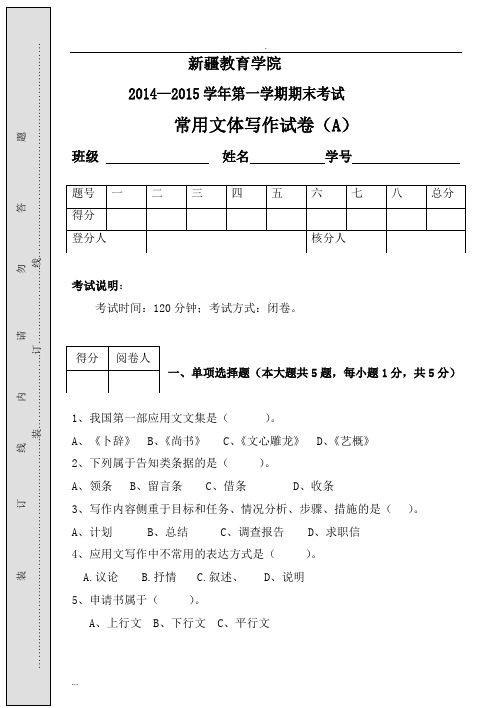
. 新疆教育学院 2014—2015学年第一学期期末考试 常用文体写作试卷(A ) 班级 姓名 学号 考试说明: 考试时间:120分钟;考试方式:闭卷。
一、单项选择题(本大题共5题,每小题1分,共5分) 1、我国第一部应用文文集是( )。
A 、《卜辞》 B 、《尚书》 C 、《文心雕龙》 D 、《艺概》 2、下列属于告知类条据的是( )。
A 、领条 B 、留言条 C 、借条 D 、收条 3、写作内容侧重于目标和任务、情况分析、步骤、措施的是( )。
A 、计划 B 、总结 C 、调查报告 D 、求职信 4、应用文写作中不常用的表达方式是( )。
A.议论 B.抒情 C.叙述、 D 、说明 5、申请书属于( )。
A 、上行文 B 、下行文 C 、平行文.二、 填空题 (本大题共10空,每空1分,共10分)1、应用文具有 、 、 、 、 、和 6个特点。
2、通知具有 、 、 三个特点3、消息的生命是 。
三、判断对错(本大题共7题,每题1分,共7分)1、条据中涉及钱财的数字要大写,末位数字后面常常加上“整”字以示严谨。
( )2、通知的主送机关不止一个,需换行时要空两格再写。
( )3、申请书要求一文一事。
( )4、写总结一般用第三人称。
( )5、计划标题《2004年保险学知识学习计划》属于省略式标题。
( )6、感谢信的称谓一般写被感谢单位的名称或个人姓名。
( )7、总结要既报喜,又报忧。
( )四、名词解释(本大题共2小题 每题4分,共8分) 1、消息:.2、申请书:五、简答题(本大题共2题,每小题5分,共10分) Array1、通知的标题一般有哪几种形式?2、简述应用文的作用。
.六、改错题:修改下面这篇通知(共15分)××县人民政府转发县卫生局《关于开展全县健康普查工作的意见》的通知县府直属各单位,各乡镇人民政府:县府经过认真研究,同意我县卫生局“关于开展全县健康普查工作的意见”这一个文件,现转发给你们。
2014年春应用写作期末考B卷(1)

泉州财贸学校2014年秋《应用写作》期末试卷(开卷)班级▁▁▁▁座号▁▁▁▁姓名▁▁▁▁成绩▁▁▁2、请示应当;一般只写一个,需要同时送其他机关的,应当用抄送形式,但不得抄送其机关。
3、下行文指具有隶属关系的上级机关发给机关的公文。
4、公文的标题,一般由发文机关、和构成,其中还有一个连接介词为“关于”。
5、计划的三要素是:目标、、。
6、总结按其性质可分为总结和专题总结,如《××公司2014年工作总结》属于总结。
7、写调查报告一般分为三个阶段:、、梳理分析阶段。
8、演讲稿是演说者在公共场合或集会上,就某一问题宣传自己的,表达自己的情感或阐说某种事理的讲话文稿。
9、根据合同法,合同应具有以下的条款:①当事人的名称或者姓名和住所;②;③;④质量;⑤价款或者报酬;⑥履行期限、地点和方式;⑦;⑧解决争议的方法。
10、广告分为非盈利性广告和盈利性广告。
非盈利性广告也称为公益广告,它不以盈利为目的,旨在为促进社会的进步文明作公益性宣传;盈利性广告是为了产品、提供服务而通过宣传,刺激诱发消费者的购买兴趣或接受服务所作的广告。
二、选择题(每题2分,共30分)1.公文中兼用的表达方式是______。
A.议论、描写、说明B.说明、议论、抒情C.叙述、议论、说明D.说明、描写、叙述2.下面公文中,属于下行文的是______。
A.请示B.函C.通知D.报告3. 公文正文中的导语用来______。
A.引述领导人的讲话B.表明制发公文的依据、目的或原因C.表明公文撰写的时间和地点D.作公文开头的谦语4. 抄送机关指______。
A.收文机关B.办理或答复收文的机关C.需要了解收文内容的机关D.必须送达的机关5. 撰写批复,开头应写明_____。
A.上级机关的指示B.国家的有关法规C.下级机关的工作情况D.针对请示的日期与标题6. 写作调查报告时一般常用人称为_______。
A.第一人称B.第二人称C.第三人称D.没有特殊规定7.向不相隶属机关发文,属于______。
2013-2014-1应用文期末试卷

2013-2014-1应⽤⽂期末试卷2013-2014学年度第⼀学期期末考试2011级公共服务类专业《应⽤⽂写作基础》试卷命题⼈:潘⾦⾹⼀、单项选择题(每⼩题1分,共10分)1、应⽤⽂的⽣命线是()A、实⽤性B、真实性C、明确性D、规范性2、不同⽂体对主题有不同的提法,在应⽤性⽂章中⼀般称为()A、主题B、基本观点C、中⼼论点D、中⼼思想3、“现就有关问题请⽰如下”属于A、过渡词B、过渡句C、过渡段D、⽂题照应4、适⽤于批转或转发⽂件,包括批转下级机关的公⽂,转发上级机关或不相⾪属机关的公⽂,指的是()A、转发性通知B、发布性通知C、部署性通知D、事务性通知5、以下标题正确的是()A、×××省委批转×××市委关于帮教失⾜青年⼯作情况的请⽰B、关于请求回答调资⼯作中⼏个问题的请⽰报告C、农业厅关于请求解决农垦系统中⼩学教育经费问题的报告D、×××省⼈民政府关于批转×××同志在全省地市政法委⼯作会议上讲话的通知6、会议纪要的结构是()A、总分式B、实录式C、记叙式D、简要式7、()是最能发挥⼴播稿特点的新闻报道A、专访B、通讯C、消息D、录⾳报道8、下列关于慰问信说法表述错误的⼀项是( )。
A、慰问信可以⽤来对遇到重⼤损失和困难的群众、团体表⽰同情、问候、⿎励和关怀。
B、慰问信是向⾟勤⼯作的集体或个⼈表⽰慰劳、问候和致意的书信。
C、慰问信只能以组织的名义写。
D、节⽇期间对有关⼈员表⽰节⽇问候,也能⽤慰问信。
9、下列关于申请书表述正确的⼀项是( )。
A.申请书是个⼈因某种需要⽽写给上级的。
B.申请书只能写给单位或组织。
C.写申请书是为了表明志愿、提出请求。
D.⼊团、⼊党⽤的是志愿书,不能⽤申请书。
10、下列表述不符合倡议书、建议书和申请书基本格式的⼀项是()A.倡议书、建议书和申请书都有标题、称呼、正⽂、结语、署名和⽇期组成。
(完整word版)含答案已校正:体育单招语文真题,.docx
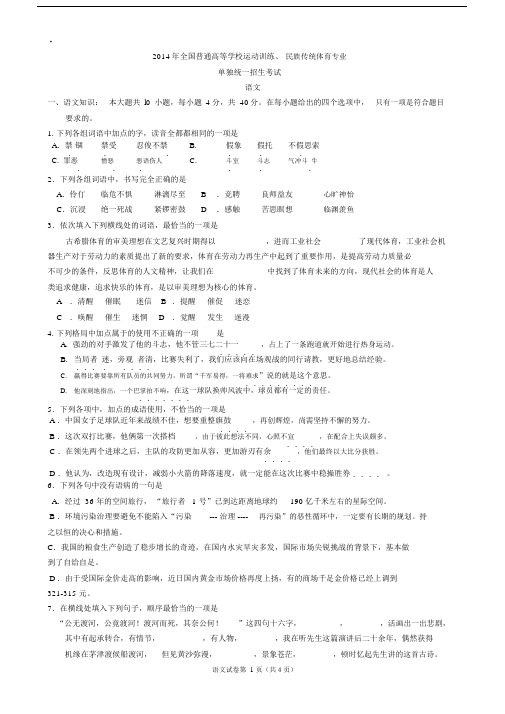
2014年全国普通高等学校运动训练、民族传统体育专业单独统一招生考试语文一、语文知识:本大题共l0小题,每小题4分,共40分。
在每小题给出的四个选项中,只有一项是符合题目要求的。
1. 下列各组词语中加点的字,读音全都都相同的一项是A.禁锢禁受忍俊不禁 B.假象假托不假思索......C. 罪恶憎恶恶语伤人 C.斗室斗志气冲斗牛......2.下列各组词语中,书写完全正确的是A.伶仃临危不惧淋漓尽至B.竞聘良师益友心旷神怡C.沉浸绝一死战紧锣密鼓D.感触苦思瞑想临渊羡鱼3.依次填入下列横线处的词语,最恰当的一项是古希腊体育的审美理想在文艺复兴时期得以_______,进而工业社会_______了现代体育,工业社会机器生产对于劳动力的素质提出了新的要求,体育在劳动力再生产中起到了重要作用,是提高劳动力质量必不可少的条件,反思体育的人文精神,让我们在_______中找到了体育未来的方向,现代社会的体育是人类追求健康,追求快乐的体育,是以审美理想为核心的体育。
A .清醒催眠迷信B.提醒催促迷恋C .唤醒催生迷惘D.觉醒发生迷漫4. 下列格局中加点属于的使用不正确的一项是A. 强劲的对手激发了他的斗志,他不管三七二十一,占上了一条跑道就开始进行热身运动。
.....B.当局者迷,旁观者清,比赛失利了,我们应该向在场观战的同行请教,更好地总结经验。
........C.赢得比赛要靠所有队员的共同努力,所谓“千军易得,一将难求”说的就是这个意思。
.........D.他深刻地指出,一个巴掌拍不响,在这一球队换帅风波中,球员都有一定的责任。
.......5.下列各项中,加点的成语使用,不恰当的一项是A .中国女子足球队近年来战绩不佳,想要重整旗鼓,再创辉煌,尚需坚持不懈的努力。
....B .这次双打比赛,他俩第一次搭档,由于彼此想法不同,心照不宣,在配合上失误颇多。
....C .在领先两个进球之后,主队的攻防更加从容,更加游刃有余,他们最终以大比分获胜。
2014年12月考试应用写作 B 卷

2014年12月考试应用写作 B 卷考试批次:201402批次课程:应用写作已做/题量20 / 20 10 / 10 5 / 5 2 / 2 2 / 2 1 / 1 40 / 40 得分/分值34 / 40 6 / 20 6 / 10 10 / 10 9 / 10 9 / 10 74 / 100一、单项选择题(共20题、总分40分、得分34分)1. 民事被告、被上诉人针对原告或被上诉人的起诉或上诉,阐述自己认定的事实和理由,予以答复和辩驳的一种书状为:() (本题分数:2 分,本题得分:2 分。
)A、民事答辩状B、刑事答辩状C、行政答辩状D、经济答辩书2. 以下哪项不是应用文最常用的表达方式()。
(本题分数:2 分,本题得分:2 分。
)A、记叙B、说明C、描写D、议论3. 下列哪项不属于制度的特点:() (本题分数:2 分,本题得分:2 分。
)A、指导性和约束性B、鞭策性和激励性C、时间性和空间性D、规范性和程序性4. 法定公文是党政机关、企事业单位依法行政的()。
(本题分数:2 分,本题得分:2 分。
)A、资料B、条件C、证明D、凭证5. 行政职能机关制定并公开发布的具有强制执行效力的规则为:() (本题分数:2 分,本题得分:2 分。
)A、行政规则B、行业规则C、部门规则D、公司规则6. 述职报告是一种()。
(本题分数:2 分,本题得分:2 分。
)A、法定公文B、法规规章性公文C、常用的事务文书D、专用文书7. 以下哪个选项不属于守则的发布方式:() (本题分数:2 分,本题得分:2 分。
)A、会议通过B、领导签署批准C、领导发言D、法定公文颁布8. 《公司发行股票章程》属于()。
(本题分数:2 分,本题得分:2 分。
)A、组织章程B、规范章程C、企业章程D、内部章程9. 一个公司的会议制度属于()。
(本题分数:2 分,本题得分:2 分。
)A、行政制度B、部门制度C、准则D、细则10. 下列哪项不属于申论考试要求:() (本题分数:2 分,本题得分:2 分。
2014年高考全国各地语文作文考试试题汇编(精编版)

2014年高考全国各地语文作文试题汇编(精编版)1.课标全国卷1(适用地区:河南、河北、山西、陕西)18.阅读下面的材料,根据要求写一篇不少于800字的文章。
(60分)“山羊过独木桥”是为民学校传统的团体比赛项目。
规则是,双方队员两两对决,同时相向而行,走上仅容一人通行的低矮独木桥,能突破对方阻拦成功过桥者获胜,最后以全队通过人数多少决定胜负。
因此习惯上,双方相遇时,会像山羊抵角一样,尽力使对方落下桥,自己通过。
不过,今年预赛中出现了新情况:有一组比赛,双方选手相遇时,互相抱住,转身换位,全都顺利过了桥。
这种做法当场就引发了观众、运动员和裁判员的激烈争论。
事后,相关的思考还在继续。
要求选好角度,确定立意,明确文体,自拟标题;不要脱离材料内容及含意的范围作文,不要套作,不得抄袭。
2.课标全国卷2(适用地区:青海、西藏、甘肃、贵州、吉林、宁夏、内蒙古、黑龙江、新疆、云南、海南)18.阅读下面的材料,根据要求写一篇不少于800字的文章。
(60分)不少人因为喜欢动物而给它们喂食,某自然保护区的公路边却有如下警示:给野生动物喂食,易使它们丧失觅食能力。
不听警告执意喂食者,将依法惩处。
要求选好角度,确定立意,明确文体,自拟标题;不要脱离材料内容及含意的范围作文,不要套作,不得抄袭。
3.大纲全国卷(适用地区:广西)21.阅读下面的文字,根据要求写一篇不少于800字的文章。
(60分)农民工老王突发胃穿孔,被送进医院。
为救治这名贫困患者,医院开通“绿色通道”给他做了手术,又进行了十天治疗。
虽然老板主动送来5000元,老王仍欠下4000多元医药费,而医院默许他出了院。
老王刚一康复就回到了工地:“哪怕打工还钱再难,我也得努力。
是医院和老板救了我。
”可欠款还是像石头一样压在他心上,最终,老王鼓足勇气找到医院,说出了想在医院打工抵债的心思。
院方深受感动,聘他为陪检员。
老王也特别敬业,作为曾经的患者,他格外懂得怎样帮助病人。
2014年湖北省技能高考文化综合语文部分
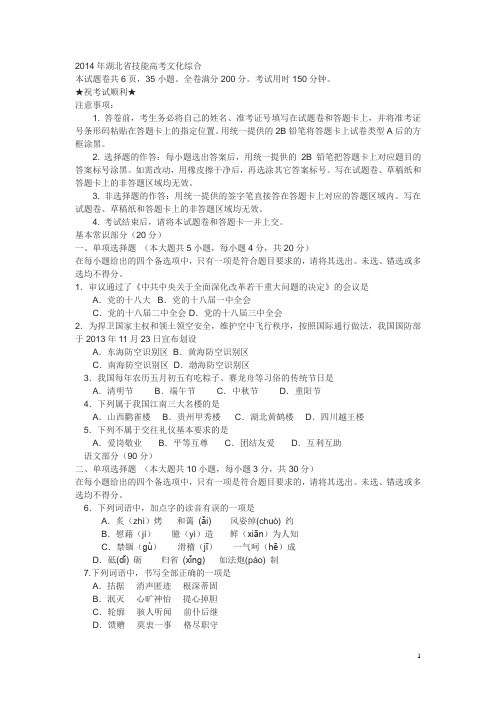
2014年湖北省技能高考文化综合本试题卷共6页,35小题。
全卷满分200分。
考试用时150分钟。
★祝考试顺利★注意事项:1. 答卷前,考生务必将自己的姓名、准考证号填写在试题卷和答题卡上,并将准考证号条形码粘贴在答题卡上的指定位置。
用统一提供的2B铅笔将答题卡上试卷类型A后的方框涂黑。
2. 选择题的作答:每小题选出答案后,用统一提供的2B铅笔把答题卡上对应题目的答案标号涂黑。
如需改动,用橡皮擦干净后,再选涂其它答案标号。
写在试题卷、草稿纸和答题卡上的非答题区域均无效。
3. 非选择题的作答:用统一提供的签字笔直接答在答题卡上对应的答题区域内。
写在试题卷、草稿纸和答题卡上的非答题区域均无效。
4. 考试结束后,请将本试题卷和答题卡一并上交。
基本常识部分(20分)一、单项选择题(本大题共5小题,每小题4分,共20分)在每小题给出的四个备选项中,只有一项是符合题目要求的,请将其选出。
未选、错选或多选均不得分。
1.审议通过了《中共中央关于全面深化改革若干重大问题的决定》的会议是A.党的十八大 B.党的十八届一中全会C.党的十八届二中全会 D.党的十八届三中全会2.为捍卫国家主权和领土领空安全,维护空中飞行秩序,按照国际通行做法,我国国防部于2013年11月23日宣布划设A.东海防空识别区 B.黄海防空识别区C.南海防空识别区 D.渤海防空识别区3.我国每年农历五月初五有吃粽子、赛龙舟等习俗的传统节日是A.清明节 B.端午节 C.中秋节 D.重阳节4.下列属于我国江南三大名楼的是A.山西鹳雀楼 B.贵州甲秀楼 C.湖北黄鹤楼 D.四川越王楼5.下列不属于交往礼仪基本要求的是A.爱岗敬业 B.平等互尊 C.团结友爱 D.互利互助语文部分(90分)二、单项选择题(本大题共10小题,每小题3分,共30分)在每小题给出的四个备选项中,只有一项是符合题目要求的,请将其选出。
未选、错选或多选均不得分。
6.下列词语中,加点字的读音有误的一项是A.炙(zhì)烤和蔼(ǎi)风姿绰(chuò) 约B.慰藉(jí)臆(yì)造鲜(xiān)为人知C.禁锢(ɡù)滑稽(jī)一气呵(hē)成D.砥(dǐ) 砺归省(xǐnɡ) 如法炮(páo) 制7.下列词语中,书写全部正确的一项是A.拮据消声匿迹根深蒂固B.泯灭心旷神怡提心掉胆C.轮廓骇人听闻前仆后继D.馈赠莫衷一事格尽职守8.依次填入下列各句横线处的词语,全都恰当的一组是①黄河是划分河南省与河北省的一条重要。
2014年全国高考语文真题文学类文本阅读题汇编.doc

2014 年全国高考文真文学文本(十五)文学文本(新卷Ⅰ)11 .下面的文字,完成 (1) ~ (4) 。
(25 分)古渡叶紫太阳地没到林中去了,晚霞散射着一片凌乱的光,映到茫无涯的淡的湖上,出各种各的色彩来。
微波着似的浪,地吻着沙岸。
破不堪的老渡船,横在枯的下面。
渡夫戴着一尖的斗笠,弯着腰,在那里洗刷一叶断片的船篷。
我地踏到他的船上,他抬起来,血色的昏花的眼睛,望着我大声道:“ 湖,小伙子?”“唔,”我放下包袱,“是的。
”“那么,要等到明天。
”他又弯腰做事去了。
“ 什么呢?”我茫然地,“我多你些不能?”“ ?你有多少呢?”他的声音来得更加响亮了,教似的。
他重新站起来,抛掉破篷子,把斗笠脱在手中,立出了白雪般的,“年,开口就是‘ ’,有就命都不要了?” 我不由得暗自吃了一惊。
他从里拿出一根烟管,地吸足了一口,接着:“看你的子也不是一个老出的。
哪里来的呀?”“从里回来。
” “ 里?⋯⋯”他又停了一停,“是当兵的吧,什么又跑开来呢 ?” “我是假的。
我病了。
”“唔!⋯⋯””两个人都沉默了一会儿,他把烟管在船上磕了两磕,接着又燃第二口。
夜色茫地侵着我的周,浪出了微微的合拍的呼。
我的心里地急,不知道老子到底要玩什么花。
于是,我:“既然不开船,老人家,就我回到岸上去找店家吧!” “店家”,老子用鼻子哼着,“年人到底不知事。
回到岸上去不同湖一的危?到去要退回七里路。
唉!年人⋯⋯就在我船中一宵吧。
” 他擦着一根火柴把我引到船艘后,了我一个两尺多的地方。
好在天气和暖,不至于十分受。
当他再擦火柴吸上了第三口姻的候,他的声音已和多了。
我躺着,一面地听着孤雁唳寂静的空,一面又留心他和我的一些江湖上的情形,和出人的秘。
“⋯⋯就算你有吧,小伙子,你也不当出来的。
湖上有多少歹人啊!⋯⋯我喜你的孝孩子。
是的,你的一定比我喜你,要是在病中看你跑回去。
只是,我呢?⋯⋯我,我有一个桂儿。
你知道?我的桂儿,他比你大得多呀!你怕不他吧?外人⋯⋯那个候,我儿同着条船。
电大开放教育本科汉语言文学专业文论专题2014年1月真题附答案及评分标准
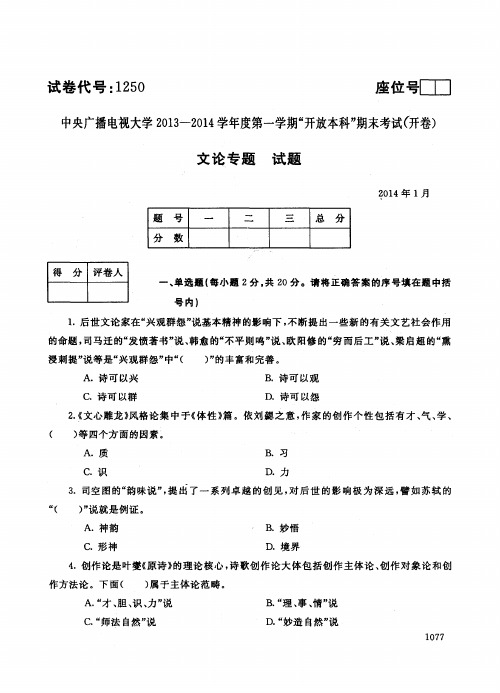
A. 泰纳 B .黑格 尔
).
C. 康德 D .克罗 齐
8. 黑格 尔 说 z " 艺 术 之所 以 异 于 宗 教 与 哲 学 , 在 于艺 术 用 (
A. 科学性 B .理性
)形式表现最崇高的东西".
C. 感性 D . 目 的 性
种空位就可以引起本文模式的相互作用。换句话说,在这里,完成作品的需要被联合本文模式
的需要代替了.只有当本文的图式被读者联系起来时,读者才开始构造想象性客体,正是空白
使这种联结性运作得以进行.这些空白表明,本文各不相同的部分应当被读者联结起来,尽管
本文并没有这样说明。空白是本文看不见的结合点,因为它们把本文的图式和本文的视野互 相区分开来,同时在读者方面引起观念化的活动。理所当然,当读者把本文图式和本文视野联
5. B
8.C
10. A
二、简答题{每小题 1 2分,共 3 6分} 1 1. 怎 样 理解 孔 子 "兴 观群怨 " 说 中 的 " 兴 " 的 含 义 , 它 与 其他 三 个层 面 " 观群 怨 " 的 关 系 是
怎样的?请简要说明。 所谓"兴",是"引譬连类","感发志意"。前一说是指文艺作用于人的方式,后一说则是指
13. 韦 勒克 、 沃 伦关 于评价文 学 的 具体标 准 有 哪 些 内 容 ?
1078
|得分|评卷人|
I
I
I
三、论述题{每题 2 2分,共 44分}
14. 从下 面 三段王 国 维 的 相关著述 , 简 单分析撞界说 的 理论 内 涵 .
应用文写作试卷及答案(北体大2014)2

应用文写作试卷及答案(北体大2014)2第一篇:应用文写作试卷及答案(北体大2014)2《应用文写作》试题一、单选(每小题1分,共10分)1、单位对外行文时,公文标题的形式是(A)A、发文机关+事由+文种B、发文机关+文种C、事由+文种2、工作报告中(B)请示事项A、可以写上B、不能夹带C、必要时可写3、为维护正常的领导、指导、直接统属的关系,上行文一般采用(B 方式A、多级行文B、逐级行文C、越级行文4、函主要用于不相隶属机关之间(A)A、商洽公务B、汇报工作C、传递文件5、《河北银行公文处理办法》规定,公文正文应使用(C)A、2号宋体B、3号宋体C、3号仿宋体6、公文的成文时间一般应当是(A)A、负责人签发的日期B、拟写公文的日期C、印制公文的日期7、对公文负有主要答复办理责任的机关是(C)A、制发机关B、抄送机关C、主送机关8、公文正文的层次序数正确的是(A)A、第一层为“一、,第二层为“(一)”,第三层为“1.”第四层为“(l)。
”B、第一层为“(一)”,第二层为“1.”,第三层为“(l)”第四层为“①”。
C、第一层为“一、,”第二层为“(一)、,”第三层为“1.”第四层为“①”。
9、公文主题词的排列顺序是(B))A、文种、类别、类属B、类别、类属、文种C、类属、类别、文种10、转发性通知主要用于(C)A、印发本部门的文件B、批转下级文件C、转发上级、平级和不相隶属机关的文件二、多项选择题(每小题2分,共10分)1、应用写作的语体风格是((ABDE)A、准确B、简明C、形象D、平实E、庄重2、下列文种既可用作上行文又可用作下行文的是(BC)A、通知B、意见C、函D、报告E、批复3、计划正文部分的主要内容是(ABCDE)A、目标任务B、措施方法C、时间步骤D、执行部门E、执行要求4、公文发文字号的组成要素有(CDE)A、文种B、事由C、机关代字D、年份E、顺序号5、作为公文的报告按用途可分为(ADE)A、工作报告B、意见报告C请示报告D、情况报告E、答复报告三、简答题(每小题5分,共25分)1、《国家行政机关公文处理办法》规定:“‘请示’应当一文一事;一般只写一个主送机关”,请解释为什么要作此规定?1、《国家行政机关公文处理办法》规定:“‘请示’应当一文一事;一般只写一个主送机关”,请解释为什么要作此规定?答:便于上级处理请示事项,及时给予批复,提高办事效率。
- 1、下载文档前请自行甄别文档内容的完整性,平台不提供额外的编辑、内容补充、找答案等附加服务。
- 2、"仅部分预览"的文档,不可在线预览部分如存在完整性等问题,可反馈申请退款(可完整预览的文档不适用该条件!)。
- 3、如文档侵犯您的权益,请联系客服反馈,我们会尽快为您处理(人工客服工作时间:9:00-18:30)。
湖南科技学院二○一四年下学期期末考试英语专业2012 年级英语文体学试题考试类型:开卷试卷类型:A卷考试时量:120 分钟出卷人:唐建福题号I II III IV V 总分统分人得分阅卷人复查人I1. Style can defined as the ⑴linguistic habit of different people or characteristic of typical social situations.2. Stylistics may be defined as the study of or the investigation of ⑵style.3. Phoneme is the smallest ⑶sound unit in a specific language capable of semantic distinction.4. Dialect is a subtype of language which may be determined by ⑷geographical locality or particular social groupings.5. The three factors of register are ⑸field, tenor, and mode.6. General stylistics is chiefly concerned with the investigation of the ⑹linguistic features of all kinds of language use.7. A sentence made up of two or more simple sentences, joined together by conjunctions or punctuations is a ⑺compound sentence.8. Pause can be divided into voiced pause and ⑻silent pause.9. The rise-fall pitch is employed to give people a sincere praise or to show the feeling of⑼shock.10. The fall-rise pitch is used to give people some encouragement or give people a ⑽warning.11. The rising pitch is employed to show the meaning of indefiniteness, uncertainty and ⑾incompleteness.12. The falling pitch is used to show the meaning of definiteness, certainty and ⑿completeness.13. There are ⒀5 pitches in phonetics.14. With ⒁consultative style people usually offer some background information. It is usually employed in business activities.15. To attract readers’⒂attention is one of the functions of English advertisements.16. The relationship between irony and humor is that irony is a language means while humor is an ⒃effect.17. People usually use casual style between friends, acquaintances, or insiders. Its mainfeature is that people usually employ ellipsis, ⒄slangs or cants with it.18. Stress, ⒅intonation, pause, and voice quality are the 4 phonetic means in English.19.II.Multiple-choice (Attention: there is only one or more than one choice to one question). (2′×10=20′)1. The smallest unit in a language that carries meaning is .A. phemeB. morphemeC. phoneD. word2. What figure of speech has been used in “the young hunter was as strong as a lion”?A. metaphorB. metonymyC. synecdocheD. simile3. Which of the following are the types of change of meaning of English words?A. extensionB. specializationC. degradationD. elevation (ABCD)4. What are the basic components of the English vocabulary. (ACD)A. Anglo-SaxonB. GreekC. LatinD. French5. Stylistics is the study or the investigation of style.A. yesB. no6. What figure of speech has been used in “many hands make light work”?A. ironyB. overstatementC. synecdocheD. oxymoron7. Which of the following originate from Anglo-Saxon? (AB)A. members of the familyB. timeC. lawD. science8. What are the functions of inverted sentence? (BCD)A. For effectB. For emphasisC. For balanceD. For cohesion and conjunction9. What are the levels of stylistic analysis? (ABCD)A. Phonological levelB. Lexical level D. Syntactic level D. Discoursal level10. What are the grammatical functions of stress? (ABCD)A. Emphasize a certain word or meaning.B. Distinguish words, phrases, same spelling, different meaning.C. Change of stress in words causes change of phonemesD. Means of expressing strong emotions.1. What is the methodology of stylistic analysis? (A)A. linguistic analysisB. discourse analysis2. What are the stylistic functions of syntactic deviations in literature? (ABCD)A. As a marker of one’s social backgroundB. As a means of characterizationC. Social positionD. Irony, satire, emphasis, comical effects3. Structurally speaking, sentences may classified into: (ACD)A. Simple sentenceB. Exclamatory sentenceC. Compound sentenceD. Complex sentence4. What are the differences between language and speech? (ABCD)A. Language is abstract whereas speech is concrete.B. Language is potential whereas speech is actual.C. Language is code whereas speech is message.D. Language is stable and systematic whereas speech is subject to personal andsituational constraint.5. Functionally speaking, what types do English sentences have? (ABCD)A. DeclarativeB. InterrogativeC. ExclamatoryD. Imperative6. What are the gestures that may be used in a casual conversation? (ABCD)A. Facial expressionsB. eye-contactC. environmentD. clothing7. Five styles were advanced by Martin Joos in the book “The Five Clocks”. And they are:(BD)A. strict styleB. frozen styleC. polite styleD. casual style8. The differences between oral communication and written communication are: (ABC)A. Use some gestures ( body language ) in oral communicationB. Use a statement as a question in oral communicationC. Use some pure oral words in oral communicationD. Use some characters in written communication9. Stress has several apparent stylistic and grammatical functions. And they are: (ABCD)A. The first function is for emphasis.B. The second function is to change the meaning or the part of speech of some words, orboth.C. The third function is to differ some English wordsD. The fourth function is to show someone’s surprise, ang er, fear, doubt, pleasure, etc.10. How do we express ourselves in a proper way? Several factors do work. And they are:(ABCD)A. PhoneticsB. VocabularyC.GrammarD.Some knowledge concerning English stylisticsIII.Please judge whether the following statements are true or false. (Attention: if it is true, please mark T; otherwise, F)(1′×10=10′)1. Euphemism is a kind of mild expression for an offensive or harsh one. (√)2. Content is the style that may be different from case to case although the meaning mayremain the same. (х)3. Exophora is an item that refers to something in another text. (х)4. Simply speaking, registers refer to languages which are determined by situation. (√)5. In this example: “Is this a non-smoker? I don’t know”, there is a Verbal ellipsis. (х)6. Rhetorical question is a question which does not need an answer or the answer is obvious. (√)7. Contrastive conjunction is achieved by the use of conjunctive words of addition orprogression, such as and, furthermore, moreover, etc. (х)8. A not-text is a group of sentences that are typically or logically linked together. Thiskind of linkage is called cohesion. So cohesion is the quality that makes a text a text.(х)9. Tenor of discourse is the social relationships between the participants in thecommunication. (√)10. The compositions written by a class of middle school students can be called differentstyles? (х)1. Syllable refers to a vowel sound either with or without a consonant or consonants inclusters. (√)2. Lexical analysis is chiefly concerned about how the words in a text are put together toproduce meaning and other kinds of message. (х)3. Syntactical analysis is chiefly concerned about how sentences are joined together toproduce a cohesive and coherent text. (х)4. Taboo refers to words forbidden to be used in public because of their being dirty oroffensive. (√)5. Technical words refer to those words used in special professions. (√)6. Loose sentence is one that is not grammatically complete until the end is reached. (х)7. Parallelism is a rhetorical device in which identical words are used but not necessarily inidentical position. (х)8. Repetition is a rhetorical device in which two or more than two similar syntacticstructures with different words are placed side by side. (х)9. Pause can be divided into structural pause and emotive pause. (√)10. Intimate style is usually used between husband and wife. Moreover it is employed injargons sometimes. (√)IV.Analyze the following passage. (Attention: please give the definition of this kind of sentence structure, its characteristics and its stylistic effects) (12%)V.Indicate what kind of figures of speech is used in the following examples. (2′×10=20′)1. ——Where have you been for the last four years?——At college taking medicine.——And did you get well? (pun)2. Life is but a brief candle. (metaphor)3. From the cradle to the grave (metonymy)4. Many hands make light work. (synecdoche)5. She’s as old as a mountain. (hyperbole)6. ——What weather do the mice dislike?——When it rains cats and dogs. (pun)7. He is a fool. He never knows where his personal interest lies. His whole heart isconcerned about the interest of other people. (irony)8. Belinda smiled, and all the world was gay. (overstatement/hyperbole)9. The drunkard loves his bottle better than his wife. (metonymy)10. ——Why are parliamentary reports called “blue books”?——Because they are never red. (pun)10. My love is a red, red rose. (metaphor)1. The young hunter was as strong as a lion. (simile)2. ——What starts with T, ends with T, and is full of T?——Teapot. (pun)——And did you get well? (pun)3. A victorious defeat (oxymoron)4. My love is a red, red rose. (metaphor)43. Name at least five kinds of figure of speech in English.Simile, metaphor, metonymy, synecdoche, irony, overstatement, etc.44. What possible social relationships exist between the participants in the following sentences? (12’)1). Excuse me, could you tell me the right time, please?2). What time is it, please?3). What’s the time?Sentence 1) shows a high degree of politeness and formality which may most probably appear in a conversation between strangers with great social distance in between.Sentence 2) still shows some degree of politeness and formality which may be in a conversation between acquaintances.Sentence 3) is a direct question without taking care of politeness. This is characteristic of conversations between friends or classmates or family members.45. Indicate what kind of figures of speech is used in the following examples.The young hunter was as strong as a lion. (simile)Life is but a brief candle. (metaphor)From the cradle to the grave (metonymy)Many hands make light work. (synecdoche)She’s as old as a mountain. (hyperbole)A victorious defeat (oxymoron)He is a fool. He never knows where his personal interest lies. His whole heart is concerned about the interest of other people. (irony)Belinda smiled, and all the world was gay. (overstatement/hyperbole)The drunkard loves his bottle better than his wife. (metonymy)My love is a red, red rose. (metaphor)7. ——What starts with T, ends with T, and is full of T?——Teapot. (pun)8. ——Where have you been for the last four years?——At college taking medicine.——And did you get well? (pun)9. ——What weather do the mice dislike?——When it rains cats and dogs. (pun)10. ——Why are parliamentary reports called “blue books”?——Because they are never red. (pun)IV.Analyze the following conversation. (Attention: please give the definition of this kind of figure of speech, and its stylistic effects) (12%)A: I have a hair-raising story to tell.B: Tell it to a bald-headed man.In this conversation, pun is used to avoid unnecessary inconveniences and also produce ambiguities which can make a humorous effect. Here person B deliberately used the dual meaning of “hair-raising”to express his unwillingness to listen to person A’s story in a friendly and humorous way. The phrase “hair-raising” means either growing hair or dreadful.Susan: Jim, can you give me Lincoln’s Gettysburg Address?Jim: No, but he used to live at the white house in Washington DC.In this conversation, pun is used to produce ambiguities which can make a humorous effect. The humor is produced through Jim’s failure to correctly understand the meaning of the word “address” here. Susan means the speech while the student interprets it as the place where Lincoln lived.26. Explain the connotative meaning of the underlined words in the following sentence.She knows nothing about the cruelty about the world. She is a lily.Lily is a flower and by cultural conventions a symbol of purity and innocence in the west.Why should we learn and study English stylistics? (10′)a) It will help us to express ourselves in English properly.b) It will help us to know something about language features of a variety of English written styles.c) It will help us to select a proper way for getting the best language effects and attaining our communicative purposes.d) It will help us to go at literary criticism.e) It will help us to do the translation work well.。
